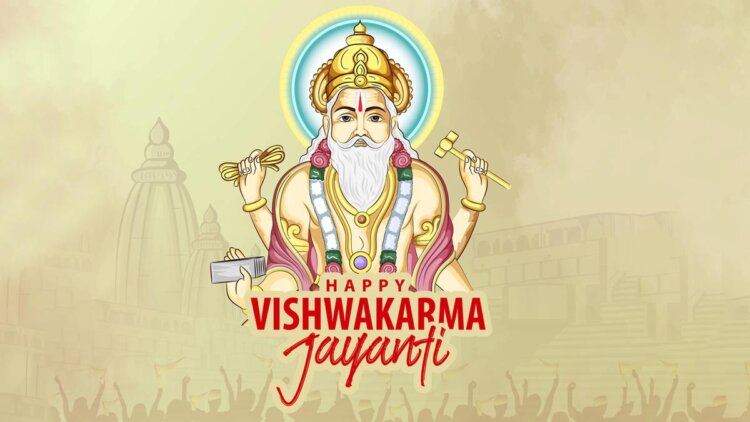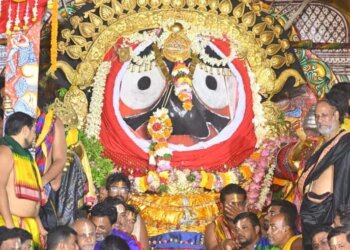Vishwakarma Jayanti is a Hindu festival commemorating the birth of Lord Vishwakarma, the universe’s divine architect and craftsman. He is the first engineer in the world and the son of Lord Brahma, the creator of the universe. In addition, he is the patron deity of artisans, engineers, architects, mechanics, and manufacturing workers.
Vishwakarma Puja, also known as Vishwakarma Jayanti or Bhadra Sankranti, is an auspicious holiday celebrated throughout the country with tremendous fanfare. On this day, people worship Lord Vishwakarma, the celestial carpenter and principal architect of the world, who is also the son of Lord Brahma. Devotees in industry worship machinery and keep a Lord Vishwakarma idol at their homes or places of business. The event falls on Kanya Sankranti, the day when the sun shifts from Simha Rashi (Leo) to Kanya Rashi (Virgo). Lord Vishwakarma, according to Hindu legend, has four hands, rides a goose, and carries a measuring tape, a scale, a book, and a pot. Finally, Vishwakarma puja is lavishly celebrated in Odisha, Tripura, West Bengal, Uttar Pradesh, Karnataka, Bihar, Jharkhand, and Assam.
According to the Hindu calendar, Vishwakarma Puja is observed every year on the last day of the month of Bhadrapada. This usually falls in September according to the Gregorian calendar. In 2023, Vishwakarma Puja will be celebrated on Sunday, September 17.
Vishwakarma Puja history
The origins of Vishwakarma Jayanti can be found in ancient Indian literature and traditions. The Rigveda, one of the oldest Hindu scriptures, has the first mentions of Vishwakarma Jayanti. Vishwakarma is revered as the celestial designer of the universe in Hindu mythology. Lord Shiva’s Trishul, Lord Vishnu’s Sudarshana Chakra, Lanka King Ravana’s Pushpaka Vimana and Indra’s Vajra, Dwarka, Lord Krishna’s domain, and the Maya Sabha for the Pandavas were all built by him. He also constructed many palaces for the gods of the four yugas. This festival has evolved into a significant celebration for craftsmen, workers, and artists to honor Lord Vishwakarma and seek his blessings for prosperity, invention, and talent in their respective fields.
Significance of Vishwakarma Puja
This celebration is extremely important to the inhabitants of much of the country. This auspicious day honors Lord Vishwakarma, who is revered as the celestial architect of the universe. Artists, engineers, and employees from numerous industries are honored on this day for their abilities and craftsmanship. Certain firms and businesses designate a holiday for these artisans on Vishwakarma Jayanti. To commemorate the event, some people worship an image of the deity and gift sweets to their staff.
The Vishwakarma Jayanti festival commemorates the notion that all activity, no matter how tiny, brings value to the land. This day also marks the start of new endeavors, the establishment of factories and workshops, and the worship of machinery and tools. Today, Vishwakarma Jayanti serves as a reminder of India’s rich cultural heritage and the nation’s understanding of the importance of skilled labour in supporting social progress.
Lord Vishwakarma’s Architectural Wonders:
Vishwakarma’s architectural marvels abound in Hindu mythology. He had created several towns and palaces for the gods over the four ‘yugas’. During the “Satya yuga,” he constructed the Swarg Loke, or heaven, which houses the gods and demigods and is ruled by Lord Indra. Vishwakarma then constructed ‘Sone ki Lanka’ in the “Treta yuga,” Dwarka in the “Dwapar yuga,” and Hastinapur and Indraprastha in the “Kali yuga.”
‘Sone Ki Lanka’ or Golden Lanka:
In Hindu mythology, ‘Sone ki Lanka’ or Golden Lanka was the home of the demon king Ravana during the “Treta yuga.” According to the classic story Ramayana, this was also the location where Ravana held Sita, Lord Ram’s wife, hostage.
Upon Lord Shiva’s union with Parvati, he entrusted Vishwakarma with a special task – to build a magnificent palace for their abode. Astonishingly, Vishwakarma fashioned an opulent palace entirely of gold. When it came time for the auspicious “Grihapravesh” ritual, Lord Shiva extended an invitation to the wise Ravana, seeking his expertise in conducting the housewarming ceremony. Ravana, awestruck by the beauty and grandeur of the palace, begged Shiva for the “Dakshina” after the sacred rite when Shiva urged Ravana to ask anything in return as “Dakshina,” Ravana, overwhelmed with the beauty and grandeur of the palace, asked Shiva for the golden palace itself! Shiva was obliged to accede to Ravana’s wish, and the Golden Lanka became Ravana’s palace.
Dwarka:
Among the many fabled towns Viswakarma created was Dwarka, Lord Krishna’s capital. Lord Krishna is claimed to have lived at Dwarka during the time of the Mahabharata and made it his “Karma Bhoomi,” or center of operation. That is why this location in northern India has become a popular Hindu pilgrimage.
Hastinapur:
Vishwakarma is claimed to have built Hastinapur, the capital of the warring families of the Mahabharata, during the current “Kali Yuga.” Lord Krishna made Dharmaraj Yudhisthir the ruler of Hastinapur after winning the battle of Kurukshetra.
Indraprastha:
Vishwakarma also constructed Indraprastha for the Pandavas. According to the Mahabharata, King Dhritrashtra offered the Pandavas a plot of land named ‘Khaandavprastha’ to live on. Yudhishtir followed his uncle’s orders and went to reside with the Pandava brothers in Khaandavprastha. Lord Krishna afterwards invited Vishwakarma to create a capital for the Pandavas on this territory, which he dubbed ‘Indraprastha’.
Legends tell us about Indraprastha’s architectural magnificence and beauty. The palace’s floors were so brilliantly done that they reflected water, and the pools and ponds inside the palace provided the illusion of a level surface with no water in them.
Following the completion of the palace, the Pandavas summoned the Kauravas, and Duryodhan and his brothers traveled to Indraprastha. Duryodhan was perplexed by the palace’s wonders and fell into one of the ponds since he was unaware of the palace’s glories. Draupadi, the Pandava wife who watched this scene, laughed heartily! She answered, implying Duryodhan’s father (the blind monarch Dhritrashtra), that “the son of a blind man is bound to be blind.” Duryodhan was so irritated by Draupadi’s comment that it became a key cause of the epic Kurukshetra war chronicled in the Mahabharata and the Bhagavad Gita.
Vishwakarma People
The Vishwakarma People are well known as the main seed of all arts, architectural intelligents, and creators of Hindu religion and temples in India for about 5000 years. They are the Five Sons Inheritance of Sri Vishwakarma. Manu (Black Smiths), Maya (Carpenters), Twosta (Tin Smiths), Silpy (Sculptors), and Viswajna (Gold Smiths) are their names. From the First Invader, Greek Alexander, through All Invaders, Foreign Visitors, and Foreign Tourists, their Creations such as Temples, Sculptures, Weapons, Golden, Metal Made, and Wooden Things have amazed and amazed everyone.
However, 90% of the Vishwakarma people are now impoverished, illiterate, and unemployed. Because they fail to honor their primary deities, Sri Vishwakarma and Sri Gayathri Devi. Swamiji Maharaj SriSri Vishwakarmaputra Maharishi, Uttarpradesh, has pointed these out with much sadness.
Some Vishwakarma people wondered aloud, “Who are we?” Is it Saiva or Vaishnava? True Vishwakarma people are neither Saiva nor Vaishnava. Essentially, Hindu Dharma or Religion incorporates many other religions and religions inside itself. They are Saiva (God Siva’s Own Religion), Vaishnava (God Vishnu’s Own Religion), Ganapathya (God Ganesh’s Own Religion), Sowmar (God Sun’s Own Religion), Gowmar (God Karthikeya’s Own Religion), Sakkiya (Goddess Parvathi’s Own Religion), and Others. As Vishwakarma is not only a separate race, but also a special religion, and it is the most important religion in Hindu Dharma.
The Vedas refer to Vishwakarma people as Speical Creation. They are not created by Sri Brahma, who also makes people, animals, birds, and so on. Sri Vishwakarma, who created the gods and the universe, created Vishwakarma people from five heads. They have distinct identities, rites, roles, and histories. They can create new history if they follow the procedures as closely as possible.
Vishwakarma Jayanti is a celebration that celebrates India’s rich cultural legacy as well as the value of skilled labor in the construction and advancement of civilization. It is a day to honor Lord Vishwakarma, the almighty architect and craftsman of the cosmos who inspires millions of artisans and craftspeople across India. It is a day to recognize their abilities and inventiveness, as well as to seek their advice and blessings for a happy future.
Source:HT/VS







 Finance
Finance







